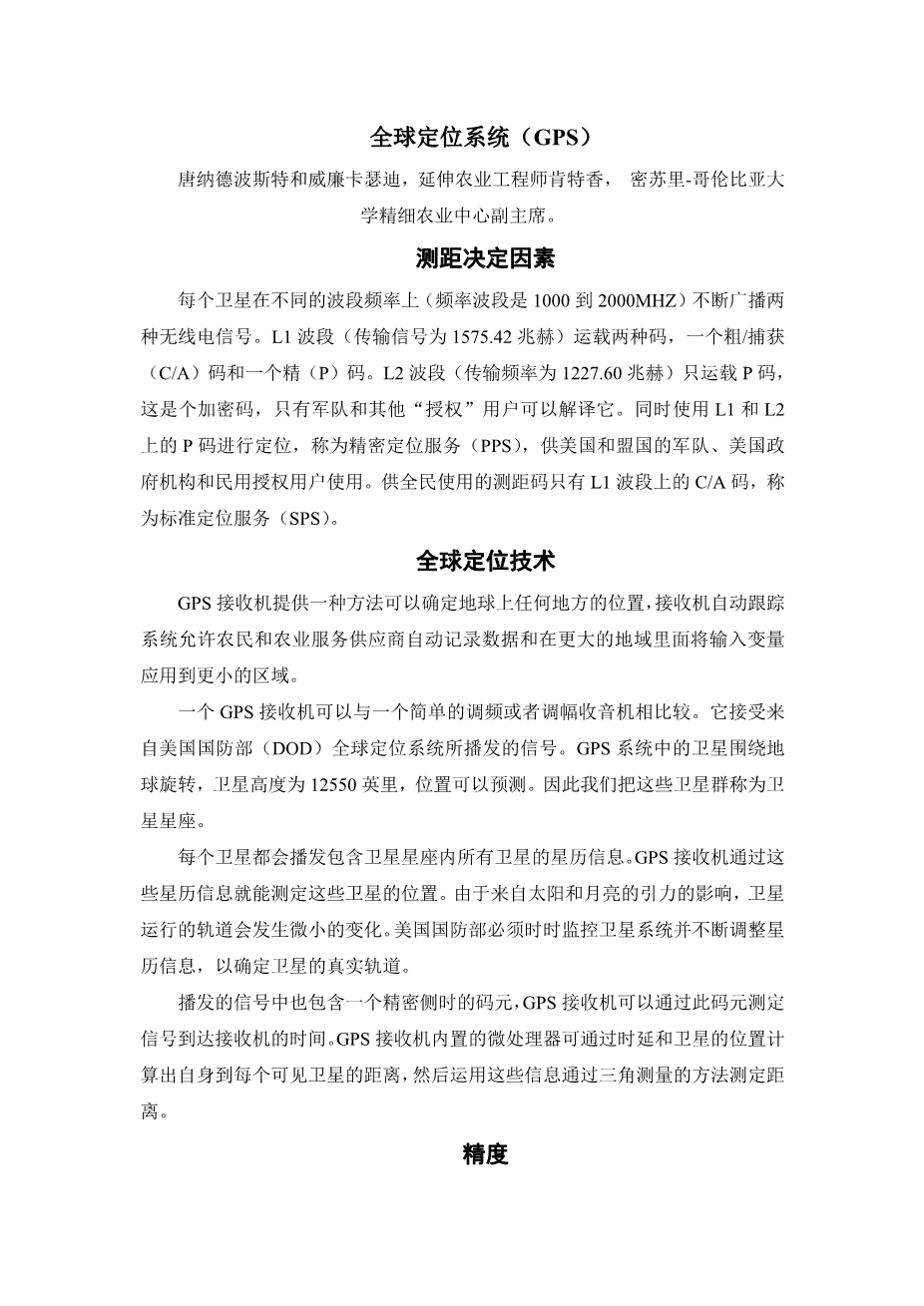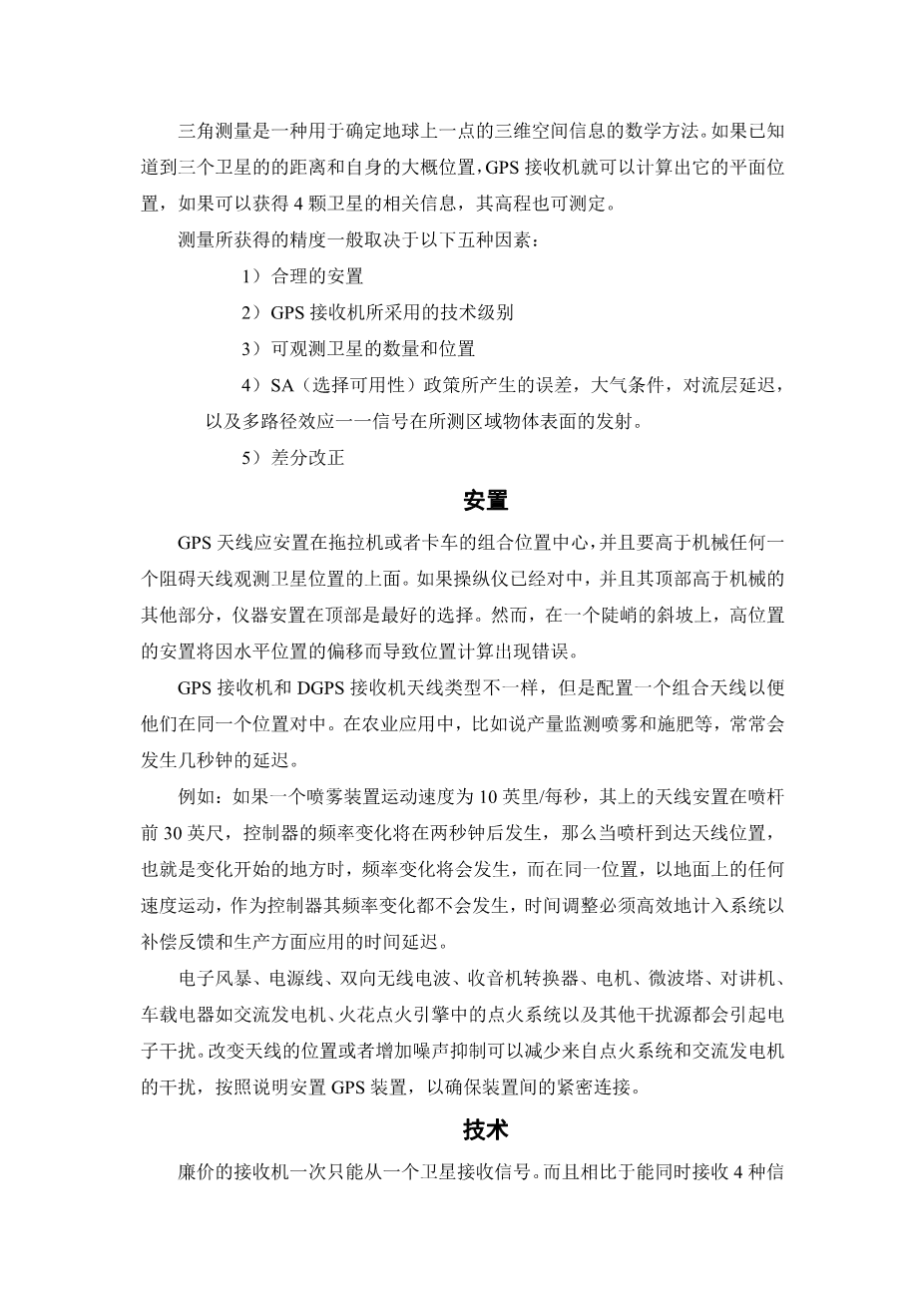Global Positioning System (GPS)
Donald Pfost and William Casady, Extension Agricultural Engineers Kent Shannon, Associate Director of the Missouri Precision Agriculture Center University of Missouri-Columbia
Range determination factors
Each GPS satellite continuously broadcasts two radio signals on separate L-band frequencies (the L-band is from 1,000 to 2,000 MHz). The L1 signal (transmitted at 1575.42 MHz) carries two codes, a Coarse/Acquisition (C/A) code and a Precision (P) code. The L2 signal (transmitted at 1227.60 MHz) carries only the P code, which is encrypted so only the military and other “authorized” receivers can interpret it. The use of both the L1 and L2 signals and their P codes produces what is called the Precise Positioning Service (PPS) and is available to the U.S. and allied military, U.S. government agencies and authorized civilian users. The system available for all civilian use accesses only the L1signal and the C/A code and is known as the Standard Positioning Service.
GPS technology
Global Positioning System (GPS) receivers provide a method for determining location anywhere on the earth. Accurate, automated position tracking with GPS receivers allows farmers and agricultural service providers to automatically record data and apply variable rates of inputs to smaller areas within larger fields
A GPS receiver can be compared with a simple AM or FM radio. A GPS receiver “listens” for the signals that are broadcast from the satellites of the United States Department of Defense (DOD) Global Positioning System. Orbiting around the earth at an altitude of 12,550 miles, these satellites are in predictable locations; hence, we refer to the system of satellites as the GPS constellation.
Each satellite broadcasts almanac information containing the position of all satellites in the constellation. GPS receivers use the almanac to determine the position of the satellites. Minor variations in the orbits of the satellites occur due to gravitational forces from the sun and the moon. The DOD continuously monitors the satellites and adjusts the almanac information to represent the actual orbits of the satellites.
The broadcast signals also contain a precisely timed predictable code that a GPS receiver can use to deter-mine how long the signal required to reach the receiver. A microprocessor within a GPS receiver uses these delays and the position of the satellite to calculate the distance to each satellite, and then uses this information to determine location through triangulation.
Triangulation is a mathematical method for locating points on a plane in three-dimensional space. If the distances to each of three satellites and your approximate location on the earth are known, the GPS receiver can calculate its terrestrial position. If information from four satellites is available, elevation can also be determined.
Accuracy
The accuracy obtained generally depends on five factors
1) proper installation
2) the degree of technology used in the receiver
3) the number and location of satellites
4) errors introduced by selective availability(SA), atmospheric conditions, the troposphere, the ionosphere, and multipathing 一 radio signals bouncing off objects in the area
5) differential corrections.
Installation
GPS antennas should be mounted on the centerline of a combine, tractor or truck and above any part of the machinery that might obstruct a line of sight to a satellite. If the cab is centered and the top of the cab is above other portions of the machine, a cab-top mounting maybe the best location. However, on a steep side slope, a high mounting point will result in an error in position calculation due to the offset in horizontal position.
GPS and DGPS receivers may have separate antennas but usually there will be a combination antenna so that both are centered at the same location. A delay of several seconds often occurs in agricultural applications such as yield monitoring, spraying and fertilizer application.
Example: If the antenna on a sprayer traveling 10 mph is mounted 30 ft ahead of the booms and a rate change at the controller is effected at the boom two seconds later, the rate change will occur when the booms reach the location of the antenna where the change was made. At any other ground speed, the rate change at the booms will not occur at the same location as the controller. A time adjustment mustusually be factored into the system to compensate for time delays in sensing or product application.
Electrical interference can result from electrical storms, power lines, 2-way radios, nearby radio transmitters, electric motors, microwave towers, cellular phones, vehicular electrical equipment such as alternators and ignition systems on spark-ignition engines and other sources. Changing the position of the antenna or adding noise suppression kits may reduce interference problems from alternators and ignition systems. Follow the instructions for installation of the GPS equipment, making sure that all connections are tight.
Technology
Low-cost receivers receive signals from one satellite at a time and require more time to determine the location than a receiver capable of receiving four signals simultaneously. Usually, seven to 10 satellites are in view at any one time and more sophisticated receivers will produce the most accurate location.
Reacquisition time is the time it takes to get an accurate position fix after a short-time loss of satellite signals; this may occur for a variety of reasons, including traveling near trees or buildings and losing the lsquo;line of sightrsquo; to satellites. Reacquisition time is important for most agricultural applications and especially for guidance with applicators and aircraft
剩余内容已隐藏,支付完成后下载完整资料


英语译文共 9 页,剩余内容已隐藏,支付完成后下载完整资料
资料编号:[240381],资料为PDF文档或Word文档,PDF文档可免费转换为Word
以上是毕业论文外文翻译,课题毕业论文、任务书、文献综述、开题报告、程序设计、图纸设计等资料可联系客服协助查找。


